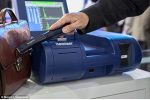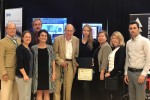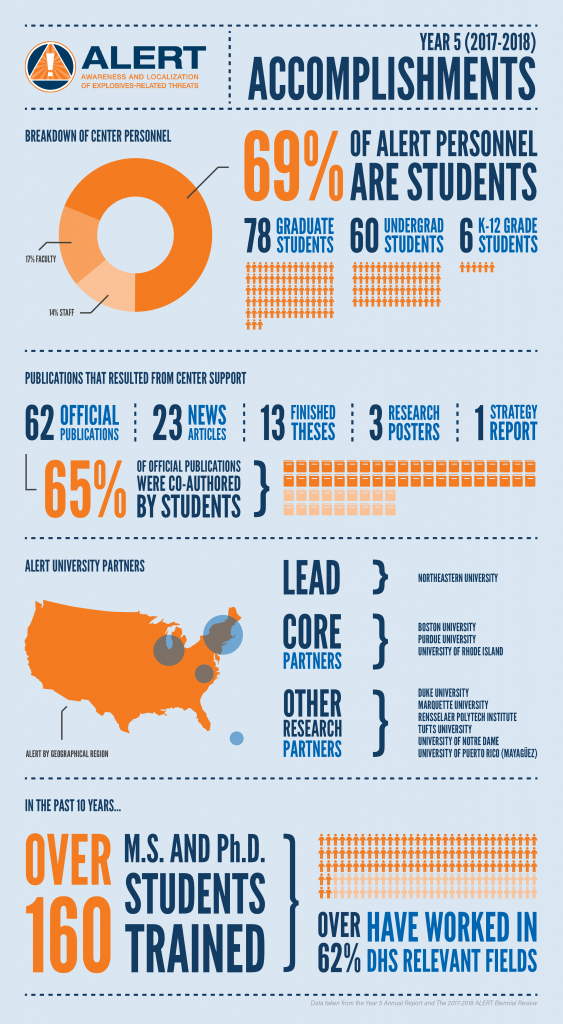News & Events
Awards and Achievements
ALERT Awarded Two New Homeland Security Task Orders December 17, 2020

Novel Technologies and Processes to Support Interdiction of Illicit Materials Task Order
ALERT received a task order from the U.S. Department of Homeland Security Science and Technology Directorate (DHS S&T) to support a two-year project known as “Novel Technologies and Processes to Support Interdiction of Illicit Materials,” with a specific focus on the mission needs of U.S. Customs and Border Protection (CBP). This task order builds on ALERT’s existing systems, methods, and algorithms for explosive threat detection, and it aims to improve DHS’s capabilities with respect to detection and interception of prohibited narcotics, agricultural products, currency, intellectual property, and other illegal goods entering through airports, land-border crossings, seaports, mail facilities, and cruise line terminals. ALERT will focus on facilitating the development of existing and emerging technologies and methodologies related to inspection of vehicles, people, mail, and containers in more efficient, effective, and cost-saving ways. This project will also assess the application of artificial intelligence and machine learning for DHS’s automated threat detection, operator assist algorithms, reconstruction algorithms, data-fusing algorithms, and cyber security efforts. ALERT brings specialized knowledge to this project with respect to projection and X-ray computed tomography at multiple energies, trace and vapor detection, Raman scatter spectroscopy, and more.
Enhanced Trace Explosives Detection, an Ambient Desorption Ionization Retrofitted Explosives Trace Detector Solution and a Continuous Automatic Non-Contact Sampler Based on Remote Heating Task Order
ALERT has received a task order from DHS S&T to support a one-year project known as, “Enhanced Trace Explosives Detection, an Ambient Desorption Ionization Retrofitted ETD Solution and a Continuous Automatic Non-Contact Sampler Based on Remote Heating.” This project’s tasks will be spearheaded by ALERT Thrust 1 Lead, Professor Jimmie Oxley (University of Rhode Island), Dr. Miriam Fico of ALERT’s industrial partner Smiths Detection, and ALERT collaborator, Avi Cagan of Eneregan, LLC.
ETDs are regularly used by DHS as a screening tool, but current ETDs have limitations. One component of this project will focus on the development of an Ambient Desorption Ionization module and its integration with currently deployed ETDs to selectively identify current and emerging explosives threats. This ADI retrofit solution greatly enhances ETD capabilities. Further, the work will include the investigation of novel non-contact sampling technologies to expand the ability to perform sampling at airport checkpoints, while minimizing the chances of viral cross-contamination and improving collection efficiency. Lastly, the project will perform a scenarios-based feasibility study on explosive vapor detection.
[Photo: An example of an explosives trace detection scanner used in airports, © Morpho Detection.]
ALERT Researchers Matteo Rinaldi and Zhenyun Qian are awarded a $550K NSF Grant and patent June 30, 2020

ALERT Researchers Professor Matteo Rinaldi and Research Assistant Professor Zhenyun Qian were awarded a $550K NSF grant for “Zero Power Wireless Flame Detector for Ubiquitous Fire Monitoring” In May 2020. This award was made through NSF’s technology translation program, Partnerships for Innovation. The goal of the award is to develop a novel micromechanical flame detector which will consume near-zero power while in standby mode until triggered by the specific infrared (IR) signature emitted by a flame. Drs. Rinaldi and Qian will be working with United Technologies Corporation to develop a prototype meeting the demanding national flame detector standards that include a high level of system robustness and stability with respect to environmental variabilities such as extreme temperature and vibration. This planned wireless flame detector is intended to operate under conditions where conventional detectors are limited due to harsh environmental conditions and the zero-power consumption aspect will reduce the cost associated with standard sensor hardware.
Drs. Rinaldi and Qian were also awarded a patent for “Zero power plasmonic microelectromechanical device” in May 2020 related to their technology development for their ALERT Project R2-B.3. This research involves the development of ultra-miniaturized, low-cost, wireless IR sensors which are capable of continuously monitoring for thermal radiation associated with a threat (such as human intrusion) while consuming no power in standby mode.
Dr. Rinaldi’s research with ALERT focuses on the development of a new technology platform capable of performing multiple chemical analyses including gravimetric analysis, IR spectroscopy, and thermal analysis in a miniaturized footprint. The demonstrated technology overcomes fundamental scientific and engineering development challenges, enabling the implementation of a new generation of trace detectors that provide near real-time detection, high sensitivity, and high specificity for a targeted group of explosives, and resulting in very low false positive and false negative rates. Furthermore, the novel zero-power sensing microsystems developed in his ALERT project can enable unattended human detection for border protection by eliminating sensor maintenance cost associated with conventional detectors. Read more about Matteo Rinaldi’s work in Multi-Functional Nano-Electro-Opto-Mechanical (NEOM) Sensing Platform.
Matteo Rinaldi and Zhenyun Qian awarded patent May 14, 2020
Northeastern University’s Associate Professor of Electrical and Computer Engineering and principal investigator for Project R2-B.3, Matteo Rinaldi, and Research Assistant Professor Zhenyun Qian were awarded a patent for “Zero power plasmonic microelectromechanical device”. Read more about the patent here: https://coe.northeastern.edu/news/rinaldi-qian-awarded-patent-zero-power-plasmonic-mems/
ALERT Researchers Awarded Patent May 29, 2019

May 29, 2019
ALERT researchers, Professor Carey Rappaport and Professor Jose Martinez-Lorenzo of Northeastern University were awarded a patent for an “On-the-Move Millimeter Wave Interrogation System with a Hallway of Multiple Transmitters and Receivers” on May 21, 2019.
In conventional screening systems that use radar imaging for surveillance and detection purposes, an object of interest may be illuminated (using millimeter wave) and the scattered field measured and processed to reconstruct a feature of the object. These systems may generate an image that profiles a detectable shape, outline and/or movement of an object or subject; however, conventional radar systems, such as a portal-based system, constrains a subject from movement. Professor Rappaport and Professor Martinez-Lorenzo’s patented solution allows for screening an unconstrained subject, meaning an individual could be scanned for foreign objects attached to their bodies (such as explosives and weapons hidden under clothing) as they moved through a hallway of transmitters and receivers. Such a system could lead to faster and more accurate screening of individuals as they make their way through security checkpoints.
Read more about the “On-the-Move Millimeter Wave Interrogation System with a Hallway of Multiple Transmitters and Receivers” patent here.
To learn more about the work Professor Rappaport and Professor Martinez-Lorenzo are doing to make screening for explosives and weapons more effective and efficient, visit their respective project pages: Projects R3-A.2 and R3-A.3, and Project R3-B.1.
Infographic: ALERT’s Year 5 (2017-2018) Accomplishments January 29, 2019
January 29, 2019
As we begin the New Year, we are also looking back on the previous year! Check out our newest infographic on ALERT’s Year 5 (2017-2018) Accomplishments.
ALERT Researchers Selected as IEEE Fellows January 29, 2019

January 29, 2019
Please join us in congratulating the newly elevated IEEE Fellows for the Class of 2019! We are especially proud of ALERT researchers Mario Sznaier of Northeastern University, and David Castañón and Venkatesh Saligrama of Boston University for this significant achievement. IEEE Fellow is a distinction reserved for select IEEE members whose extraordinary accomplishments in any of the IEEE fields of interest are deemed fitting of this prestigious grade elevation. The total number selected in any one year does not exceed one-tenth of one percent of the total voting IEEE membership.
Mario Sznaier is a Northeastern University ECE Professor and co-leads ALERT Project R4-A.1. Sznaier has been elevated to an IEEE Fellow for his contributions to identification of switched systems and multiobjective control. His work on Project R4-A.1 aims to substantially enhance our ability to exploit surveillance camera networks to predict and isolate threats from explosive devices in heavily crowded public spaces, and to guide complementary detection modalities, subsequent to a threat alert.
David Castañón and Venkatesh Saligrama are Boston University ECE Professors and collaborators on ALERT Project R4-A.2. Castañón has been elevated to an IEEE Fellow for his contributions to discrete-time stochastic control and information fusion. Saligrama has been elevated to an IEEE Fellow for his contributions to distributed detection and estimation of structured signals. Their work on Project R4-A.2 aims to leverage machine learning and computer vision methods for surveillance over multi-camera networks and to develop methods that are capable of real-time and forensic detection of suspicious activity.
ALERT Awarded Two New Task Orders November 29, 2018

Maturation and Validation of Dielectric Characterization Algorithms Task Order
ALERT has received a task order contract from the Department of Homeland Security (DHS) Science & Technology Directorate (S&T) to mature and operationalize the Advanced Imaging Technology material characterization (complex dielectric constant) algorithms being developed in ALERT Projects R3-A.2 and R3-B.1, led by ALERT Researchers, Dr. Carey Rappaport and Dr. Jose Martinez-Lorenzo of Northeastern University, respectively.
The task order, known as the “Maturation and Validation of Dielectric Characterization Algorithms,” will allow ALERT to use DHS owned images captured originally for the DHS S&T/TSA “Passenger Screening Algorithm Challenge.” The data for this prize competition was originally captured on the Apex Screening at Speed (SaS) High Definition – Advanced Imaging Technology (HD-AIT) laboratory prototype designed by Pacific Northwest National Lab. These images are available in several different file formats, including raw reflectivity formats. The data also includes ground truth information including relative body zone and materials for objects of interest. In the future, this data set may be augmented with additional images from future data collections. The end state for this development is an operationally functioning algorithm that is able to:
- Integrate with provided open file formats to add material characterization capabilities to existing Automatic Threat Recognition (ATR) algorithms;
- Demonstrate performance improvements (namely false alarm rate reduction while maintaining probability of detection) over current ATR algorithms;
- Run in near-real time, almost suitable for an operational environment; and
- Provide TSO-friendly output that will classify a foreign object into one of three categories (unlikely to be explosive, possible explosive threat, and undetermined).
Correlation of Luggage and Specific Passengers (CLASP) Algorithm Maturation and Deployment Task Order
ALERT has also received a DHS S&T task order contract, titled “Correlation of Luggage and Specific Passengers (CLASP) Algorithm Maturation and Deployment,” to mature algorithms developed under the ALERT CLASP Program so that the passenger-baggage tracking capability is sufficiently robust to support operational pilots and to support risk-based screening in an airport environment. DHS S&T has a variety of projects supporting the development of next-generation aviation security capabilities as a part of its Apex Screening at Speed (SaS) Program. Under the Apex SaS Program, passenger and carry-on screening requirements have necessitated adoption of a risk-based screening approach to the aviation checkpoint. In support of these risk-based screening requirements, the Apex SaS Program seeks to develop video analytics algorithms capable of associating passengers and their carry-on items as they travel through the airport checkpoint. Combined with existing TSA technologies, these algorithms will enable risk-based screening to occur on a per passenger and per item basis, improving screening efficiency and increasing overall passenger throughput. As a secondary benefit, effective video analytics will be able to identify thefts or items left behind at the checkpoint.
DHS S&T is seeking the following from the ALERT CLASP Algorithms project to further meet the needs of the Apex SaS Program:
- Algorithms capable of associating passengers and their carry-on items as they traverse the airport checkpoint that are robust to variations in lighting, passenger density, glare, camera angles, etc;
- Requirements and best practices for algorithm deployment in an operational environment (recommended hardware, configurations, etc.); and
- Algorithms capable of leveraging passenger/bag association information to identify actions at the checkpoint (such as interaction with scanning equipment, item theft, or items left behind).
ALERT Researchers Awarded Best Paper at 2018 ICDSC Conference September 27, 2018

September 27, 2018
Dr. Octavia Camps (Project R4-A.1; Northeastern University), Dr. Richard Radke (Project R4-A.3; Rensselaer Polytechnic Institute), and their research team received the Best Paper Award at the 2018 International Conference on Distributed Smart Cameras (ICDSC) in Eindhoven, Netherlands on September 3-4, 2018.
The paper, titled “Correlating Belongings with Passengers in a Simulated Airport Security Checkpoint,” is co-authored by Ashraful Islam, Yuexi Zhang, Dong Yin, Octavia Camps and Richard Radke. The research for this paper was done using data collected for CLASP (Correlating Luggage and Specific Passengers) project at ALERT’s Video Analytics Lab located at the Kostas Research Institute for Homeland Security at Northeastern University.
According to the paper’s abstract, “Automatic algorithms for tracking and associating passengers and their divested objects at an airport security screening checkpoint would have great potential for improving checkpoint efficiency, including flow analysis, theft detection, line-of-sight maintenance, and risk-based screening. In this paper, we present algorithms for these tracking and association problems and demonstrate their effectiveness in a full-scale physical simulation of an airport security screening checkpoint. Our algorithms leverage both hand-crafted and deep-learning-based approaches for passenger and bin tracking, and are able to accurately track and associate objects through a ceiling-mounted multi-camera array. We validate our algorithm on ground-truthed datasets collected at the simulated checkpoint that reflect natural passenger behavior, achieving high rates of passenger/object/transfer event detection while maintaining low false alarm and mismatch rates.”
Click here to read the paper and learn more about this research.
2018 DHS COE Summit Facilitates Collaboration and Advances DHS Mission July 31, 2018

ALERT, along with other current and emeritus DHS Centers of Excellence (COEs), hosted the 2018 Centers of Excellence Summit in Arlington, Virginia on May 30-31, 2018. The event focused on the topic of “University Research and Development to Protect the Homeland.” The DHS COE Summit provided the Centers of Excellence an opportunity to showcase their innovative solutions to homeland security challenges and facilitate collaboration across homeland security enterprise leadership and component end-users and industry participants. According to ALERT Center Director, Michael B. Silevitch,
“One of the most valuable aspects of the Summit was the teamwork needed to pull it together. It required a concerted effort by all of the COEs to organize and orchestrate the event. Going forward, this teamwork will lead to meaningful cross-center collaboration.”
The agenda for the two-day long summit was launched with a keynote address from Christopher C. Krebs, Senior Official Performing the Duties of Under Secretary, National Protection and Programs Directorate (NPPD) and included talks by various security administrators, panel discussions, student posters, and a technology showcase.
Director Silevitch moderated a panel focused on “Transportation and Critical Infrastructure” on the first day of the summit. Panelists Carl Crawford, Eva Lee, David Nicol, and Detlof VonWinterfeldt addressed four questions related to this topic:
- What are some of the grand challenges that need to be addressed to enable the next generation of Homeland Security transportation and critical infrastructure solutions?
- What research needs to be done in order to address these challenges?
- How can the research outcomes be effectively transitioned to the field?
- What metrics can be used to enable a cost-benefit analysis of the research/transition impact?
ALERT’s Transition Team made connections with end users at the technology showcase and featured some of ALERT’s latest solutions in multi-view air cargo CT scanners, effective personnel screening, video tracking at the airport security checkpoint, and K9 explosives training aids.
COEs excel in advancing the state of the art thanks in large part to their student researchers. To acknowledge this, the summit provided students with the opportunity to present their work to attendees. Katherine Graham, one of ALERT’s talented undergraduate researchers, took home the Best Poster Award for her work on “Compressive Reflector Antennas for High-Sensing Capacity Imaging Applications.” These antenna designs provide a less complex and lower cost solution for high-sensing capacity millimeter wave imaging systems. Millimeter wave imaging systems have the potential for use in several near-field imaging applications such as security screening, non-destructive testing, autonomous driving, and biotechnology. The abstracts for the COE Summit student posters are available for download on the COE Summit 2018 website.
The summit provided an all-hands-on-deck approach to addressing homeland security challenges by bringing together some of the nation’s best academic, public, and private sector leaders to discuss strategies for advancing the mission of the Department of Homeland Security. ALERT looks forward to the next DHS COE Summit, and hopes you will join us there!
ALERT Research Highlight: The Largest and Most Systematic Re-id Benchmark to Date May 30, 2018

May 30, 2018
ALERT researchers Professor Octavia Camps (Northeastern University, Project R4-A.1) and Professor Rich Radke (Rensselaer Polytechnic Institute, Project R4-A.3) and their students, Srikrishna Karanam, Mengran Gou, Ziyan Wu, and Angels Rates-Borras, were recently published in the Institute of Electrical and Electronics Engineers’ (IEEE) monthly journal, Transactions on Pattern Analysis and Machine Intelligence (download here). The paper, “A Systematic Evaluation and Benchmark for Person Re-Identification: Features, Metrics, and Datasets,” provides an extensive review and performance evaluation of existing person re-identification algorithms.
Person identification, or re-id, matches observations of individuals across multiple camera views in a network of surveillance cameras, and represents a critical task in most surveillance and security applications. For example, a law enforcement officer may want to automatically follow a person of interest tagged at a check-in counter through the branching concourses of an airport. The research team’s recent review and evaluation of re-id algorithms helps characterize what re-id algorithms are currently capable of accomplishing, as well as what is missing and what is possible in the future. In this paper, the researchers discuss insights gained from their study, as well as put forth research directions and recommendations for re-id researchers that would help develop better algorithms in the future. Both Professor Camps and Professor Radke are involved with ALERT’s Research Thrust 4, which focuses on video surveillance and the analysis of video data with novel algorithms. This publication was the result of years of research and collaboration between their respective labs.
The fundamental re-id problem is to compare a person of interest as seen in a “probe” camera view to a “gallery” of candidates captured from a camera that does not overlap with the probe camera. If a true match to the probe exists in the gallery, it should have a high matching score, or rank, compared to incorrect candidates. Since the body of research in re-id is increasing, researchers can begin to draw conclusions about the best combinations of algorithmic subcomponents. In this paper, the researchers present a careful, fair, and systematic evaluation of feature extraction, metric learning, and multi-shot ranking algorithms proposed for re-id on a wide variety of benchmark datasets. Their general evaluation framework considers hundreds of combinations of feature extraction and metric learning algorithms for single-shot and multi-shot datasets.
The research team evaluated 276 algorithm combinations on 10 single-shot re-id datasets and 646 algorithm combinations on 7 multi-shot re-id datasets, making the proposed study the largest and most systematic re-id benchmark to date. Approaches were evaluated using 17 datasets that mimic real world settings, including the ALERT Airport Re-Identification Dataset. As part of the evaluation, the researchers built a public code library with an easy-to-use input/output code structure and uniform algorithm parameters that includes 11 contemporary feature extraction and 22 metric learning and ranking algorithms. Both the code library and the complete benchmark results are publicly available for community use.


